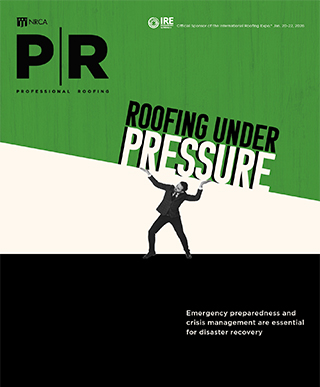
The construction industry has been facing a skilled labor shortage for quite some time. In January, the Associated Builders and Contractors estimated the industry will need to attract 439,000 new workers in 2025 to meet anticipated demand for construction services. Because of this, many roofing contractors have turned to subcontractors to fill gaps in labor.
But before making any decisions, contractors need to consider the benefits and drawbacks of using subcontractor labor, from greater efficiency and reduced costs to extensive vetting processes and even potential legal trouble.
This month, Professional Roofing spoke with roofing contractors about their experiences using subcontractor labor.
Prequalification
A vital aspect of hiring subcontractors is the prequalifying and training process. For some contractors, this includes visiting subcontractors on job sites to evaluate their performances.
Bob Morgan, CEO of Upstate Roofing & Painting, Rochester, N.Y., has been using subcontracted labor since 2023.
“In 2024, we drove 6½ hours to visit a new subcontractor,” he says.
Similarly, Tupac de la Cruz, operations manager at Roofing Solutions, Baton Rouge, La., visits job sites to assess cleanliness, safety and quality standards among other things. His company also verifies subcontractors’ references.
“Once they are approved, training occurs at the foreman level, where subcontractors receive hands-on instruction,” de la Cruz says. “Additionally, we ensure all new subcontractors undergo comprehensive safety training to align with our company standards.”
But if a contractor hires a subcontractor who has not been properly prequalified or trained and the subcontractor’s work is not adequate, the primary contractor could find itself responsible.
“If a subcontractor performs defective work, the property owner may sue the prime roofing contractor for breach of contract or negligence,” says Trent Cotney, partner and practice group leader at Adams and Reese LLP, Tampa, Fla., and NRCA’s general counsel. “Also, if a subcontractor’s actions result in damage to other people or the property, the injured party may sue the prime roofing contractor and argue it failed to properly supervise the subcontractor.”
To avoid these potential legal issues, Wendy Marvin, CEO of Matrix Roof, Vancouver, Wash., has developed a robust vetting process. Her company has been using subcontractor labor for more than 10 years, but until the COVID-19 pandemic and subsequent labor shortage, she had only used it for overflow work.
“We fully vet our contractors in all the available state informational sites,” she says. “Licenses, safety history and expiration dates are all added to their files. We sign up for notifications of any changes to those profiles so we know whether issues arise immediately. We discuss safety requirements in our initial interactions, as well as the penalties that are nonnegotiable for issues. Subcontractors have to clearly know your expectations.”
Communication
Even with successful prequalification and training, once hired, language barriers can present an issue when it comes to communication between subcontractors, other employees and customers.
Both Marvin and Morgan require foremen or other project managers to be bilingual, so they can communicate with customers.
De la Cruz has a different strategy; he notes technology has made it much easier for his company to bridge gaps in communication.
“We use translation apps that convert text messages and voice in real time,” he says. “Every subcontractor has a smartphone, making these tools highly effective for overcoming language barriers.”
Drawbacks versus benefits
Even with ways around training and communication challenges, there are plenty of other considerations contractors need to consider.
Ensuring subcontractors have adequate insurance coverage is something Morgan considers a drawback to using subcontracted labor—and another aspect Cotney notes could get a primary contractor into legal trouble. If a subcontractor lacks insurance coverage such as general liability or workers’ compensation, the primary contractor may end up financially responsible for injuries or damages, as “some states presume subcontractors’ employees are the prime roofing contractor’s responsibility unless the subcontractor provides proof of workers’ compensation insurance.”
However, Morgan believes that, if managed properly, subcontractor labor can benefit an organization. He notes subcontractors can generate added revenue and provide the opportunity to have a back-up surge crew at the company’s disposal for emergencies.
“Subcontractors are generally hard workers and take pride in their work,” he says.
Some additional drawbacks de la Cruz has experienced include a lack of direct control over subcontractors’ workforce rotation, the potential for them to work with competitors and the variability in their availability.
But de la Cruz believes the benefits of using subcontractor labor outweigh any potential drawbacks and allow for greater efficiency and flexibility in project execution. According to him, other benefits include the ability to adjust workforce size based on project needs and specialize crews by roof system type to ensure expertise in different areas.
Marvin also believes the benefits make the challenges worth it—with the right crew.
“The wrong team could really hurt,” she says. “You must trust the team to take care of your customer and do their job the way you ask. But you also must stay on top of everything legally, professionally and procedurally.”
We have been able to get through a full backlog and meet customer deadlines by providing our in-house crews with subcontractor labor
Success
When contractors find the right subcontractors for their companies and cover all their bases, they can find success.
“We have more than 20 success stories of subcontractors who have been working with us for more than a decade,” de la Cruz says. “Some have even transitioned into full-time positions with our company. Subcontracting has been a valuable strategy for our business, enabling us to deliver high-quality projects while maintaining operational agility.”
“We have been able to get through a full backlog and meet customer deadlines by providing our in-house crews with subcontractor labor,” Morgan adds. “This work would have gone to our competition if we turned down the opportunity.”
But to achieve these kinds of successes, Cotney has suggestions that should not be overlooked when hiring subcontractors.
“Have a standard operating procedure for onboarding a subcontractor, including at checklist,” he says. “Checklists can include verification of subcontractor licensure if required, making sure subcontractors have commercial general liability insurance and workers’ compensation, and a viable safety program.”
Cotney also suggests having a master subcontract agreement, which “should cover everything from indemnification to insurance and include contingent payment where allowed.”
A potential for greatness
Subcontractor labor can be a great opportunity for companies to stay on top of projects during busy periods or fill gaps during the labor shortage. Ultimately, it’s up to you to decide whether it is the right fit for your company.

Avery Timmons
Professional Roofing’s editorial assistant
NRCA



